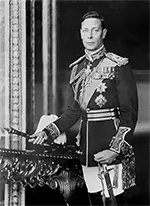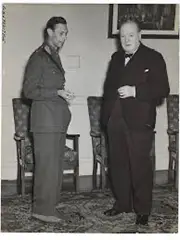King George VI of the United Kingdom
King George VI was the reigning monarch of the United Kingdom for 17 years in the 20th Century. He is most well-known for being a symbol of determination during World War II. He was born on Dec. 14, 1895, at York Cottage, on the grounds of Sandringham, in Norfolk, England. The second son of George, then Duke of York, he was born on the 34th anniversary of the death of Prince Albert, beloved husband of Queen Victoria. His parents decided to name him Albert, after his great-grandfather. The young boy became known as "Bertie." He suffered various maladies early in his life, including chronic stomach illness and knock knees, for which he wore braces. Naturally left-handed, he was forced by his tutors to write with his right hand. When Queen Victoria died in 1901, Albert's grandfather became King Edward VII and his father became the Prince of Wales. 
Albert followed in his older brother's footsteps and attended the Royal Naval College at Osborne and then Royal Naval College at Dartmouth. They had both been tutored at home. Unlike his older brother, Edward, Albert saw combat, fighting aboard the HMS Collingwood during the famous Battle of Jutland in 1916. A bout with an ulcer the following year required surgery, and he did not return to the fighting. He transferred to the Royal Air Force and became the first royal to qualify as a pilot. He studied at Trinity College, Cambridge for a year after the war, then traveled the world representing his father, who had become king in 1910. Edward was traveling as well and presented a confident, handsome, debonair image to the world. Albert was very much not that, being shy and retiring, partly because of a stammer. He later hired a speech therapist named Lionel Logue to improve his speaking ability. Unlike his brother but in a positive way (at least according to the British aristocracy), Albert married a woman of royalty (but only after she rejected two earlier proposals). He and the Lady Elizabeth Bowes-Lyon were married in Westminster Abbey on April 26, 1923. They had two daughters, Elizabeth and Margaret. 
Albert by this time had been named Duke of York, and he and his wife performed a variety of royal duties for several years. In 1936, the king died and Albert's older brother became King Edward VIII. Several months later, the king decided that he wanted to marry a woman out of favor with much of the government and aristocracy even if it meant relinquishing the throne. Edward did just that on Dec. 1, 1936, in a radio speech. Suddenly, Albert was king. He took the name George VI after his father. His coronation was in May 1937, on the day originally planned for his older brother. The new king courted controversy when he supported Prime Minister Neville Chamberlain's appeasement policy toward Germany, saying that the king was constitutionally bound to support the government's policies. In 1939, George and Elizabeth embarked on a royal world tour, visiting Canada and the United States, where they stayed at the White House as guests of then-President Franklin D. Roosevelt. George was the first monarch to visit Canada. 
World War II began that same year, and the king mad the most important speech of life in announcing that his kingdom was at war with Germany. The king and queen spent the war years helping inspire the people of the U.K. to resist the incessant bombings and threats from Germany and the troops abroad to defeat their enemies. The royal couple stayed at Buckingham Palace despite the heavy attacks on London. During the darkest days, they toured hospitals to visit with wounded soldiers. The king also visited U.K. troops in the field, in Malta, Normandy, and North Africa. He created the George Cross, to honor civilian extraordinary acts of bravery. At first, King George and Prime Minister Winston Churchill did not get along; they found a way to work together that developed into a close personal working relationship, aiding the national morale. Significantly, in 1946, a year after the war ended, the king gave the opening address at the first assembly of the United Nations. During this king's reign, the process of dissolution of the British Empire solidified in the 1931 Statute of Westminster advanced to the next step, as India and Pakistan declared their independence in 1947; leaving next were Burma (1948), Palestine (1948), and Ireland (1949). In 1947, King George toured South Africa and was horrified when told by that country's prime minister, Jan Smuts, to shake hands only with white people. In 1949, George VI began to have serious health problems, one of which was lung cancer. (He was a heavy smoker.) His oldest daughter, Princess Elizabeth, took on more royal duties, including representing her father at state events. The king went to the airport in January 1952 to give Elizabeth and her husband, Philip, a royal sendoff. He would never see them again. King George VI died on Feb. 6, 1952, at Sandringham. He was 56. His oldest daughter became Queen Elizabeth II. |
|
Social Studies for Kids
copyright 2002–2024
David White




